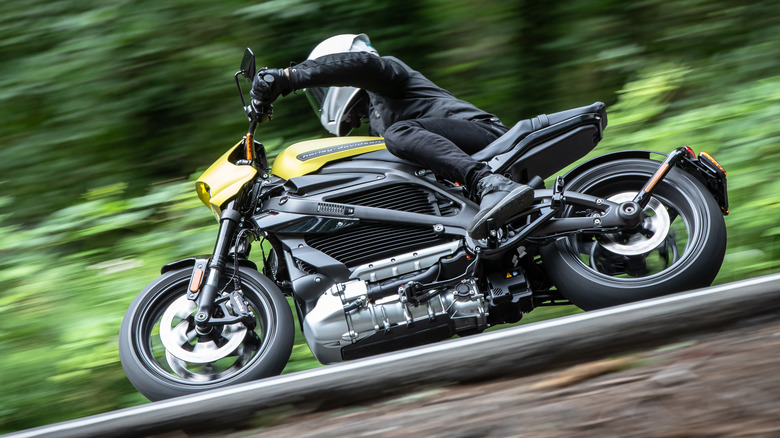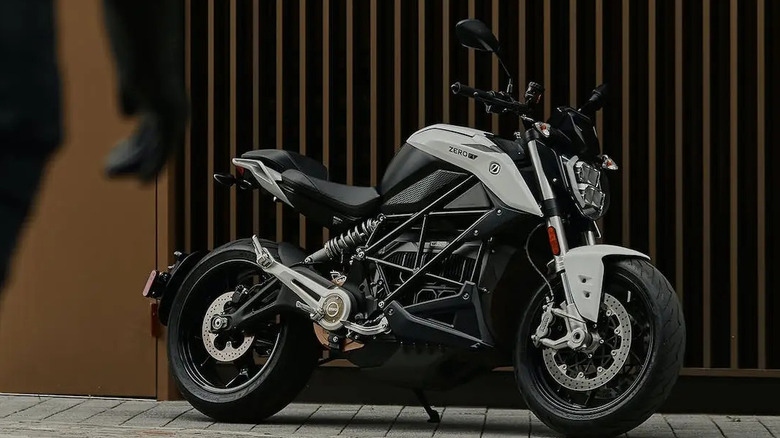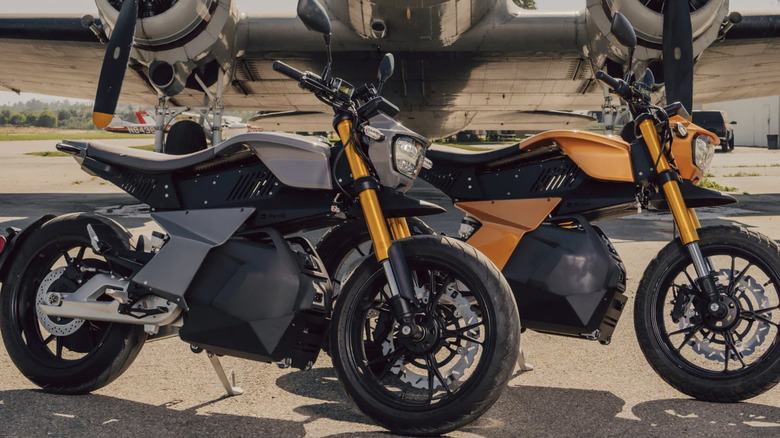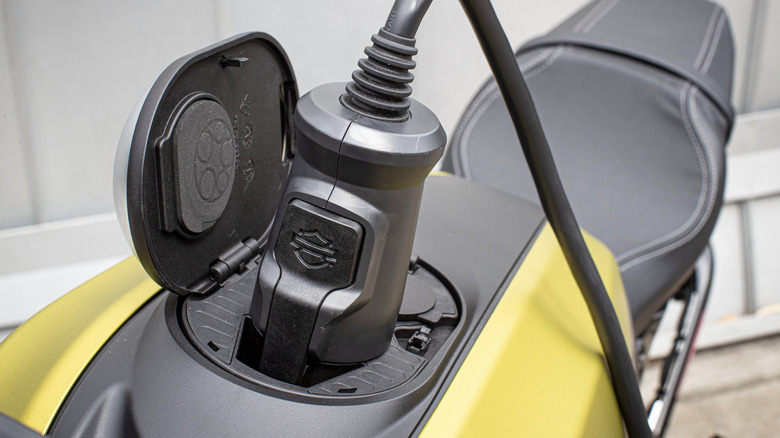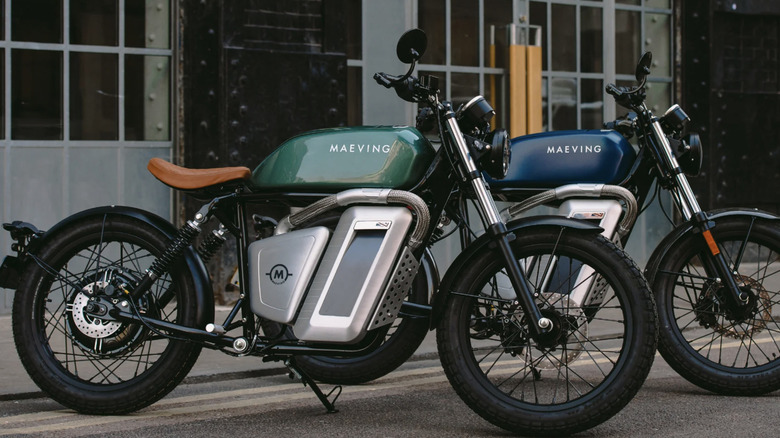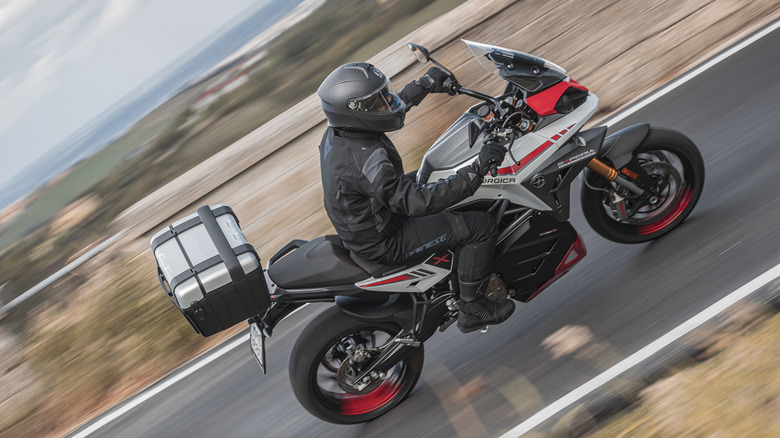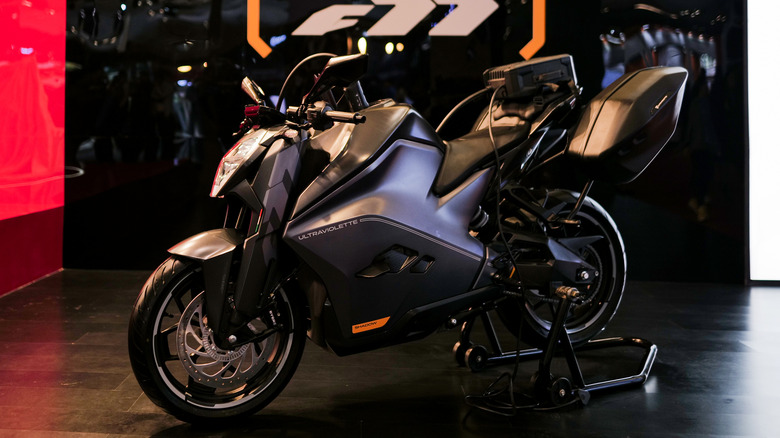Here's Why Electric Motorcycles Are So Much More Expensive Than Gas
In the world of automobiles, the general rule of thumb is that the newer the tech, the more expensive it will sell. But electric motorcycles have been around for a while, and despite all their well-documented benefits, one big disadvantage is the high asking price and tight market penetration. It is, therefore, no secret that electric scooters have seen a dramatic uptake in Asian markets, mostly due to the close price parity with ICE scooters and the savings they bring down the road.
The likes of Harley Davidson, Triumph, Honda, and Kawasaki enthusiastically aim to replicate the success of Tesla and BYD in the car segment. However, more than just technical challenges, a few additional hurdles make electric motorcycles more expensive than their combustion counterparts. In markets where electric motorcycles can make a splash with raw performance due to a higher rate of electrification, infrastructure challenges stifle their growth.
But in markets like the U.S., where the charging networks are far better, there are just not many players, and the options available are darn expensive. That also explains why high-end brands like BMW are teaming up with established local players like India's TVS to manufacture low-cost electric motorcycles without spending a fortune on R&D and building their facilities. Honda is also looking primarily at Asian markets to drive growth by focusing more on the mid-tier segment to keep costs in check.
Skewed cost dynamics
Four key hurdles exist to the broader adoption of electric motorcycles: cost, range, charging tech, and battery performance. Compared to an electric car, a motorcycle involves a considerably smaller number of parts and less tech involved. That will make one wonder why electric motorcycles didn't catch on quicker than electric cars.
Well, that predominantly comes down to the cost, most of which is hogged by the battery inside. The powertrain of a motorcycle, whether petrol or electric, constitutes a significantly larger portion of the vehicle compared to a car. Consequently, the cost of the powertrain has a more substantial influence on the overall price of the bike than it does in the case of cars.
The Australian Electric Motorcycle Company estimates that the cost of a battery pack could account for anywhere between one-third or half the motorcycle's net production costs. "While the cost of batteries continues to fall –- it's still a hell of a lot more expensive to produce a high quality, long-lasting motorcycle battery pack than a petrol engine," it says.
It estimates that, at least in this decade, the production cost of electric motorcycles will not match that of petrol-powered two-wheelers. That's quite some setback, especially compared to electric cars. Earlier this year, Volvo CEO Jim Rowan said, "price parity with combustion-engined cars is fast approaching," adding that it could be achieved by 2025. Estimates suggest electric cars will be cheaper to produce than ICE models by 2027.
Engineering challenges
Scooters have been driving up the sales of electric two-wheelers in its biggest markets. But that trend isn't reliant solely on the cost factor; engineering challenges also pose a hurdle. Scooters, with their flat footboard and significantly lower ground clearance, are conducive for designing a powertrain that allows easy placement of battery units.
When it comes to motorcycles, balancing the electric motor and the battery units without affecting vehicle stability becomes a challenge and also varies for different form factors. The technological capability for higher-performance electric vehicles is still in its early stages, and it takes years of research, development, and testing to build this capability.
Multiple areas, such as power electronics, thermal management, battery management, and safety systems, need to be addressed. Moreover, it is not as straightforward as simply borrowing innovation from electric cars and pumping it into motorcycles. This is due to motorcycles' smaller size and weight, which necessitates a more compact and efficient powertrain design.
The added weight of larger batteries significantly impacts the handling and overall driving characteristics of motorcycles. This is particularly important when riders need to balance and lean the motorcycle to execute turns. One potential solution to this issue is to position the batteries as low as possible, effectively lowering the center of gravity. However, implementing this solution on motorcycles is challenging due to their unique shape and layout.
Innovation bottlenecks
Innovation is vital, but if it doesn't change enough lives, it dies a slow death as just another scientific parlor trick. The status of the electric motorcycle segment was not what it was half a decade ago, but the breakthroughs made in that spell haven't hit the asphalt in any meaningful capacity. Let's start with the biggest challenges — charging and speed. Take, for example, Triumph's TE-1, which is claimed to achieve zero to 60 mph figures in just 3.6 seconds and fill up an empty tank up to 80% in just 20 minutes.
The biggest problem here? Well, it's still in the prototype stage. Indian upstart Ultraviolette made waves with the F77 electric sports bike, which promises a range close to 190 miles. Still, the lack of charging infrastructure in the country makes it a pricey purchase, even though a 3kW DC charger can fully juice it up in roughly 1.5 hours. But the higher performance figures come with a caveat.
The Triumph TE-1's bold numbers also prove to be its undoing, as the range is just around 100 miles. The Livewire S2 Del Mar from the house of Harley Davidson can push zero to 60 mph in sharp three seconds but only lasts 43 miles at a highway cruising speed of 70 mph. But at the end of the day, the lucky few who make positive strides and make the right compromises have to charge for the cost of innovation, and not every enthusiast can absorb that.
Standardization, or the lack thereof
Carrying over the innovation dilemma is the question of standardization in the electric motorcycle segment. The fragmented charging infrastructure is one of the biggest challenges for the EV segment. It took nearly a decade and a half before rival carmakers warmed up to the standardization formula of the NACS charger championed by Tesla.
Right now, there are at least four major types of charging connectors in the market, but the one gaining the most traction is the Combined Charging System (CCS), particularly in Europe. Key industry players such as Energica are actively pushing for the CCS to be adapted as the standardized solution, just the way NACS has found acceptance in the electric car segment.
But that is impossible unless more industry players sit at the same table or the government mandates it. China has mandated the GB/T as a national charging standard, which has played a key role in the country's world-leading EV adoption. Japan has CHAdeMO, while India's BIS has also pushed its combined AC/DC charging connector standard for light electric vehicles such as bikes.
That is going to bring down costs, but so far, fragmentation remains a problem. Two of India's biggest electric two-wheeler sellers, Ola and Ather, use their proprietary connectors and maintain a charger network. That drives up the cost of their scooters, which is passed down to the buyer.
Production conundrum
It's a chicken-and-egg situation. Big-name brands typically require large volume sales to maintain mass rollout from assembly lines. This is due to the high costs associated with large-scale manufacturing processes. Such deep-pocket labels can work on low-profit margins but ultimately rake in the big money with volume sales. Livia Cevolini, CEO of Energica, pointed out that "major manufacturers need sales in the tens of thousands region to justify the costs of mass production," according to research (PDF) courtesy of the University of New South Wales.
But these companies usually have reputations to protect and expectations to satisfy, making them less enthusiastic about embracing new technological shifts despite the benefits they bring. That leaves smaller companies bearing the onus of innovation while working with low volumes and facing uncertain financial prospects for the immediate future. Despite making high-quality products, playing with low production volumes necessitates higher profit margins to keep the ball rolling, which means the price of such bikes is on the higher side.
The cost of high-performance electric bikes poses an inherent challenge to their success. However, due to their limited production, it becomes necessary for manufacturers to price them higher in order to ensure financial viability. That puts us back on square one. So, what we're left with are established brands that play it safe with good old-fashioned funding. They can't blindly burn money at R&D. Instead; they need to make sure those investments pay off with some seriously profitable models.
To swap, or not
Another factor contributing to the high battery-associated costs of electric motorcycles is the charging situation. Unlike an electric car, motorcycles come equipped with a smaller battery that must be recharged more frequently. Naturally, more charge-discharge cycles mean a quicker pace of electrochemical degradation. That leaves only a few options. Either slow down the process, miniaturize the exact same battery tech as electric cars, or look for a novel solution.
The first two aren't exactly a cakewalk and would take a long spell of testing and validation to implement. That leaves the doors open for an alternate option. For electric motorcycles, that alternative solution could very well be battery swapping. It's not an alien concept, and the likes of Nio and Geely have already expanded beyond China and implemented the idea in Europe. California-based startup Ample also has similar plans for the U.S. market. Makers of scooters, predominantly, and even motorcycle brands such as Maeving are open to the idea of battery swaps.
But there are constraints. First, most electric mobility brands want to sell their rides atop promises of their in-house battery technology advancements. Second, owners are concerned that their new vehicles' batteries could forever be gone or mishandled after swapping them at a station. But most importantly, finding brands willing to adopt a common battery-swapping architecture and stockpiling a cache of swappable batteries is a pricey endeavor. Tesla abandoned the idea only after a single station and Better Place failed quickly.
